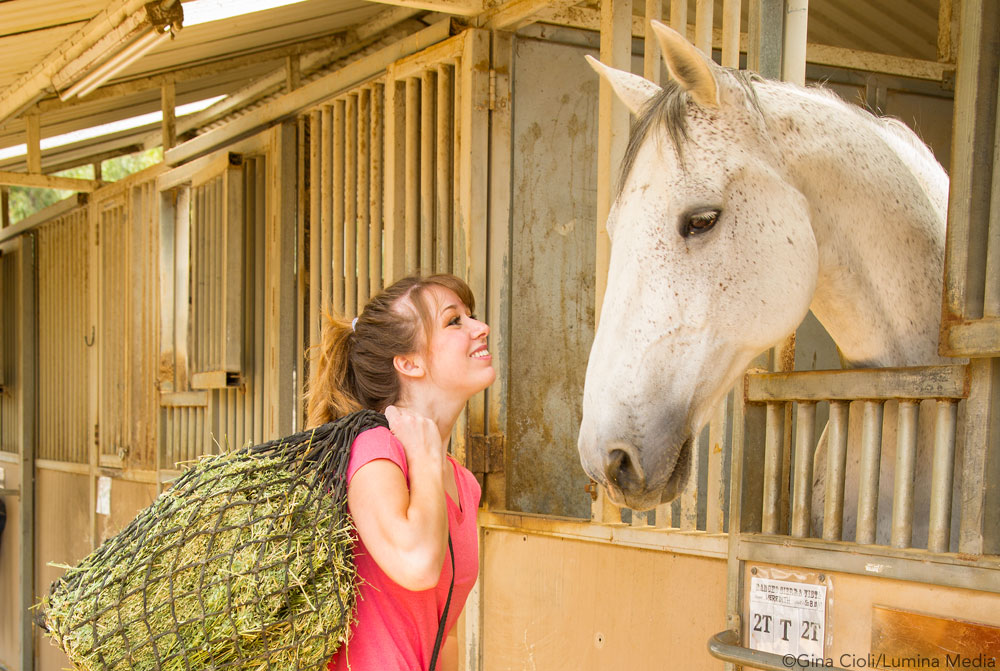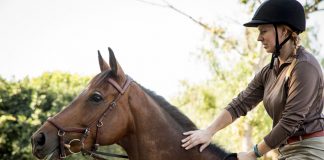
Equestrians know that riding horses is just a small part of what we do. That’s our vacation from the grind of back-breaking chores around the farm: mucking stalls, stacking hay bales, carrying bags of grain and sweeping aisles. While that’s a workout in itself, you still need to prepare your body for the onslaught of abuse it will take in a typical week.
“There are a lot of things I think we do in the barn that just wreck your body, and we don’t even think twice about it,” says Bridget Braden-Olson, owner of BioRider Fitness. “The best thing you can do for your body is to prepare it for the work you’ll do, and that’s with strength training.”
Proper Form Protects
When it comes to lifting heavy things, you always hear “bend your knees, not your back.” A strong core is important for your daily life, in and out of the barn.
“Think about lifting a bale of hay,” says Braden-Olson. “You’re doing a basic deadlift, but you want to keep your shoulders back and your back flat so the spine stays straight for natural core engagement. Doing those three things allows you to bend at the hips and pick up the bale of hay.”
One way to check the longevity of your core engagement by performing a simple exercise:
Lie on your back with your spine smoothly touching the ground and your knees bent or straight. Draw your belly button into your spine without arching your back or lifting your spine off the ground. Try to hold that for 30 seconds, continuing to breathe evenly while keeping your core engaged.
“You can feel when your core gives,” says Braden-Olson. “I think that’s where people get in trouble when it comes to chores: Their core isn’t fully engaged and doesn’t have the endurance to sustain engagement under strenuous movements or heavy carries.”
When lifting heavy things, such as a hay bale, Braden-Olson says you should think about stacking your body in a straight line: your shoulders should be stacked over your hips and your hips stacked over your heels. Having that shoulder-hip alignment with a straight spine and a strong core will give you more strength than by using your arms alone.
Special Equipment
There are some things you can use to help ease the pain and the workload around the barn.
Back Support: Bridget Braden-Olson, owner of BioRider Fitness, recommends wearing a back support when you’re doing lots of heavy lifting, such as putting up hay for the winter. “I don’t recommend wearing one while you train because you want to strengthen those muscles, but if you’re lifting more than usual, it’s worth wearing to give you some extra support,” she says.
Moving Dolly: Using a dolly, much like what movers use for heavy boxes, can help you move cumbersome objects like multiple hay bales, bags of grain or muck buckets with ease.
Two-Wheeled Wheelbarrow: If you have many stalls to clean or need to move lots of hay bales, you can’t go wrong with a two-wheeled wheelbarrow. Having two wheels means you don’t have to worry about the wheelbarrow falling over if it’s unbalanced, plus they are usually larger and deeper, which means more room to haul things.
Ergonomic Muck Fork: You might want to consider an ergonomic muck fork with a shaped handle, designed to be easier on your back. These are often constructed from a strong, lightweight material. Closely spaced tines keep manure from falling through, with many made of break-resistant materials.
Hose Reel: Using a hose reel can help reduce lugging around long hoses and having to gather them in one spot. It’ll also help keep your barn tidy and reduce the tripping hazard that occurs when hoses are left out.
Recommended Exercises
1. Squats:
We’ve covered squats in previous columns, but they are one of the most basic movements you can do to strengthen your lower body.
Stand upright with your feet hip-width apart, chest up and shoulders back, then push your hips back (which transfers the weight to your heels) and lower your body into a squat, keeping your knees straight and behind the toe. You’ll want to go as low as you comfortably can, but at least aim for your thighs to be parallel with the floor. As you stand up, drive up through your heels and extend your body up without lifting your toes off the ground.
2. Lunge with a Twist:
Braden-Olson likes to use this movement to strengthen the body for efforts like mucking stalls and raking the arena.
A lunge is when you take a step forward while keeping one foot back. Bend your front leg at the knee in a 90-degree angle, keeping your knee behind the toe, while your back knee goes down towards the ground. When you stand up, drive up through your front heel, engaging the backs of your thighs (hamstrings) and glutes.
Add onto this movement by twisting your torso in the direction of the front leg when you go down. (So if your right leg is in front, twist to the right.) You can add resistance to this movement by holding hand weights or a medicine ball.
Repeat this with nine more lunges before turning around and doing 10 with the other leg leading.
3. Bending Row:
Another exercise to prepare your upper body and arms for heavy chores is a bent-over low row, says Braden-Olson.
With your feet together or hip-width apart, hinge at the hips with a slight bend in your knees, keeping a flat back. Holding a weight in each hand, let your arms hang, engage your core, and keep your chest and chin up. Pull the weights up to your stomach while maintaining a bend from the hips, keeping your elbows in. Squeeze your shoulder blades together and pause for a second, then release without releasing your stance. Repeat this 10 to 12 times.
Braden-Olson also suggests you make an effort to switch arms when raking or picking stalls. “You want to be as even as possible with your body, so try to do equal amounts of work on both sides,” she says. “If you pick stalls everyday, and you only do it on one side, I guarantee that one side is more developed than the other.”
See all Fit Rider resources >>
Megan Arszman is a freelance writer based in Indiana, where she’s learning to balance motherhood with horses, dogs and writing.
This article originally appeared in the September 2016 issue of Horse Illustrated magazine. Click here to subscribe!






